The 5 Best Anti-Fatigue Mats, Based on 6 Months of Testing
Dotdash Meredith and Yahoo Inc. may earn commission or revenue on some items through the links below.
If meal prep is a pain, these anti-fatigue mats can help your achy legs, back, and feet.
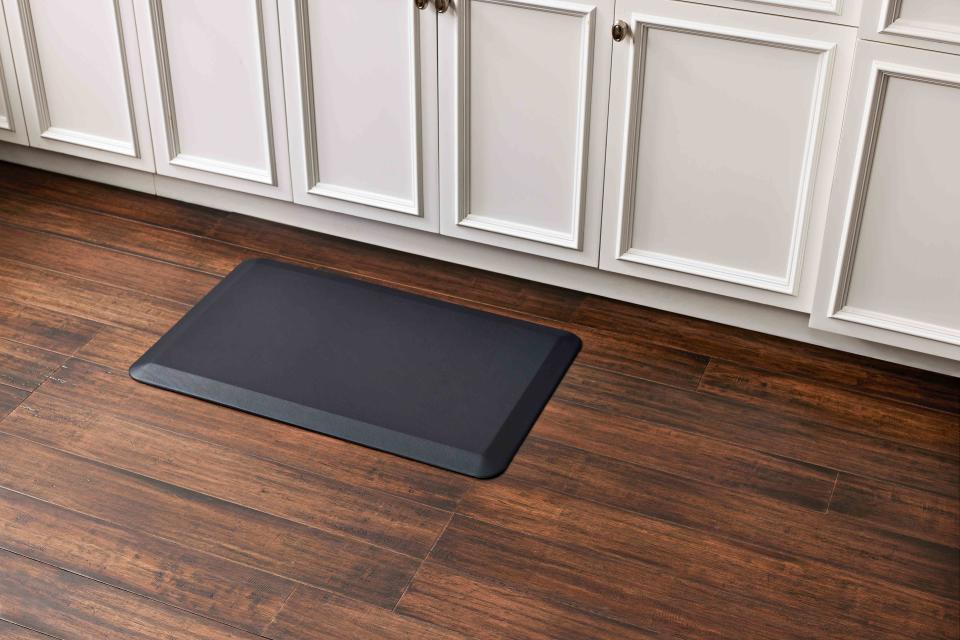
Food & Wine / Fred Hardy
When you're prepping and cooking a big meal, at some point your focus naturally shifts from the food to your aching legs, back, and feet. The longer you stand, the more you feel your posture suffer. But adding an anti-fatigue mat — an often forgotten element in a kitchen setup — may help alleviate the discomfort or pain of standing for an extended time.
When picking out an anti-fatigue mat, choose one made from durable, stain-resistant material with a cushion that will provide adequate support through the feet, legs, and back as you stand. Other key attributes we considered for this list included size, thickness, and details like anti-slip properties and beveled edges to prevent tripping. Read on for the best anti-fatigue mats to add comfort (and perhaps some color) to your floor.
Best Overall: Gorilla Grip Anti Fatigue Cushioned Comfort Mat

Pros
This mat is available in a variety of sizes to suit any kitchen space. It's also easy to clean.
Cons
The high-density foam may take some time to loosen up and feel more comfortable.
A combination of comfort and design makes this anti-fatigue mat from Gorilla Grip our top choice. Take it from one tester, who's used the mat for an average of 20 to 30 hours per week over six months: "There's a huge difference in feel between this mat and the older mats I have in other places in my kitchen," she says. This mat is made of high-density foam and covered in pebbled rubber, providing grip and padding to make it more comfortable to stand on for long periods. We've found that it helps us stand up straight, avoiding the bad posture that can cause discomfort when standing. And as frequently as we've used it over six months, no indentations or impressions have formed.
We tested the 32- by 20-inch size, which has a decent amount of space if you're working in a stationary spot. It's also available in sizes ranging from 17 by 24 inches to 70 by 24 inches, plus over a dozen colors, so you can coordinate your mat with your existing decor. The rubber surface resists water and staining, which makes it a great option for the sink or stove. Easy to maintain, it cleans up with a quick rinse.
Price at time of publish: $40
Dimensions: 32 x 20 inches
Thickness: 0.75 inches
Weight: 2.85 pounds
Material: Rubber and high-density foam
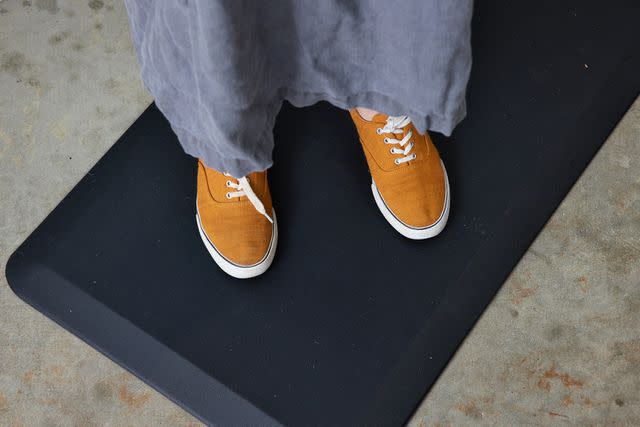
Best Value: AmazonBasics Premium Anti-Fatigue Standing Comfort Mat

Pros
Simple in design, these mats are easy to clean and provide a decent amount of cushion.
Cons
This mat is not as thick and cushiony as others. It is only available in one size and two color options.
If budget is a concern, this option from Amazon Basics is a no-frills mat that will help keep fatigue at bay. Made of high-density foam and a rubber coating, the cushioned mat provides additional support for the feet and legs while also preventing slipping. Even though this mat is just over a half-inch thick, which makes it one of the thinnest mats in our lineup, we found that it's maintained its cushioning over six months of using it. "The mat makes my workspace more bearable on long days," says one tester, who spends hours on her feet as a recipe developer and stylist.
The rubber outer coating helps protect the mat from spills and stains and is easy to clean. The lack of size and color options is a downside, but if the size works for your space and you're fine with a basic brown or black color, this mat will suit you — at a great price, too.
Price at time of publish: $22
Dimensions: 36 x 20 inches
Thickness: 0.6 inches
Weight: 3.3 pounds
Material: Rubber and high-density foam
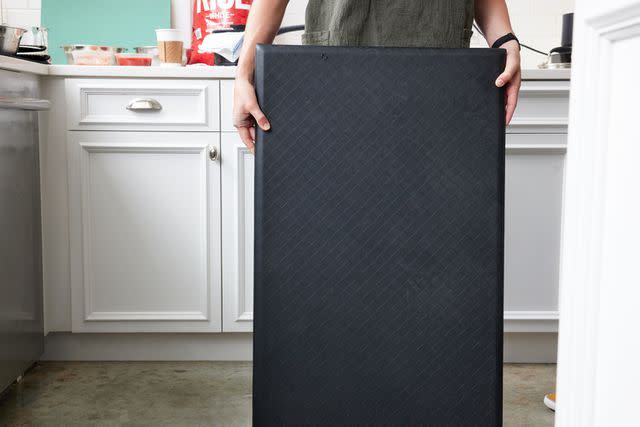
Best Splurge: GelPro NewLife Anti Fatigue Mat

Pros
This thick mat feels firm but cushioned, and commercial-grade foam ensures durability.
Cons
Color choices are limited.
GelPro's commercial-grade mat feels more luxurious than its competitors thanks to a few features. Dense memory foam provides plenty of support and cushioning — our feet never left impressions on it — and its quality has held up over six months. The tapered edges make sure there's a smooth transition from the mat to the floor, and the heavier weight means that it won't budge from its spot. The mat is pretty easy to clean, though it took some scrubbing to remove sticky spills.
Price at time of publish: $80
Dimensions: 32 x 20 inches
Thickness: 0.75 inches
Weight: 4.5 pounds
Material: High-density foam

Best Hybrid: FEATOL Standing Desk Mat Foam Cushioned Anti Fatigue Mats Comfort Standing Pad

Pros
It's a great option for someone who wants thicker padding under their feet. It's also very durable.
Cons
It's not as easy to clean as some other mats.
This mat from Featol combines gel and memory foam, making it one of the cushiest we tested. It's also one of the thickest we tested, measuring 0.9 inches tall. We've found the mat's non-slip claims hold up, as beveled edges that gently slope to the floor keep it in place (and prevent tripping). It's held up over six months. We can thank, in part, its leather-like polyurethane top, which resists tears, cracks, and punctures. That said, the texture of this mat makes scrubbing off spills or stains a bit more difficult than others.
Price at time of publish: $30
Dimensions: 32 x 20 inches
Thickness: 0.9 inches
Weight: 5.14 pounds
Material: Gel and memory foam
Best Firm: KANGAROO 3/4" Thick Superior Comfort Mat

Pros
It comes in more than a dozen colors and six sizes.
Cons
It's not as easy to clean messy spills from this mat because of its textured surface.
Comfortable but certainly not squishy, this Kangaroo mat stood out as one of the firmest we tested. We felt supported from heel to toe — one tester noted that her weight felt evenly distributed when standing. Yet, the ideal level of firmness comes down to preference, as another tester considers it stiff and wishes it felt more "broken in" after six months. That said, we agree that it hasn't changed since we first received it. Our main con is with the mat's textured diamond pattern, as it requires a little more effort to clean sometimes. Otherwise, we've maintained it by wiping it down with a damp cloth or using a vacuum to sweep away debris.
Price at time of publish: $44
Dimensions: 32 x 20 inches
Thickness: 1.25 inches
Weight: 2.82 pounds
Material: Rubber and high-density foam
Our Favorite
In our tests, the Gorilla Grip Anti-Fatigue Cushioned Comfort Mat stood out for being comfortable to stand on for hours as well as easy to clean, resisting stains and water. We also recommend it as the best overall anti-fatigue mat based on the number of colors and sizes it comes in — this mat would make a seamless addition to any kitchen.
The Tests
We began our tests with 16 anti-fatigue mats. We stood on them while cooking in our test kitchen, noting how our feet, ankles, knees, hips, back, and shoulders felt after each hour. Afterward, we dirtied the mats with flour and molasses, let them sit for 12 hours, then cleaned them. From there, we used a set of criteria to assess each mat's performance, durability, comfort, design, and ease of cleaning. We tallied the scores, and the nine mats that ranked the highest moved on to our long-term testing.
To assess how the best anti-fatigue mats held up over time, we began incorporating them into our daily routines, from prepping food to washing dishes. After using the mats for six months, we reassessed how durable and comfortable they felt to us and whether their quality had deteriorated in any way. We then narrowed down our list from nine anti-fatigue mats to the five best of the best.
Factors to Consider
Dimensions
The ideal anti-fatigue mat will be as large as you need it to be: if you only need it to stand in front of the stove or sink, a smaller mat will support you as you stand in one place. But if you have a long countertop and want the option to have the mat underneath your feet at all times, you'll want a runner-style option that you can use wherever you stand.
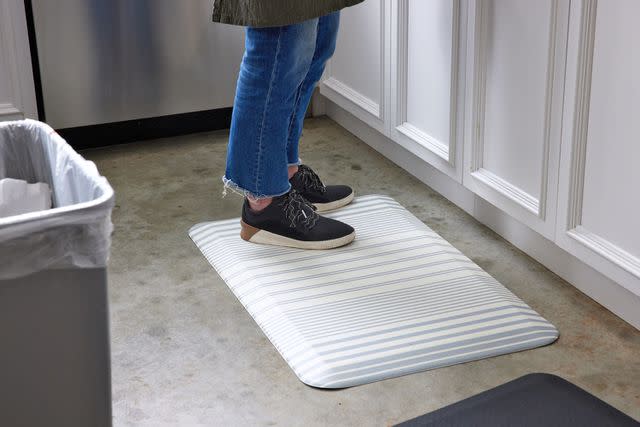
Thickness
Anti-fatigue mats range in thickness, but on average, a good quality mat has a thickness of around 0.75 inches. This gives a nice amount of cushion without feeling like you're standing on a noticeably higher surface. Some may prefer a thicker mat that provides more support, though it does add a slight distance between the counter and your hands.
Material
Look for non-absorbent materials. This is important so your mats don't get water logged or mildewed. Sturdy materials like rubber and a high-density foam core will give you support with a little bit of cushion. Other materials like gel can provide cushion, but you'll want to test out if the support is adequate. Other features to look for include anti-slip backing to keep the mat in place, a beveled edge to prevent tripping or catching the edge of the mat, and textured surfaces that provide more tread.
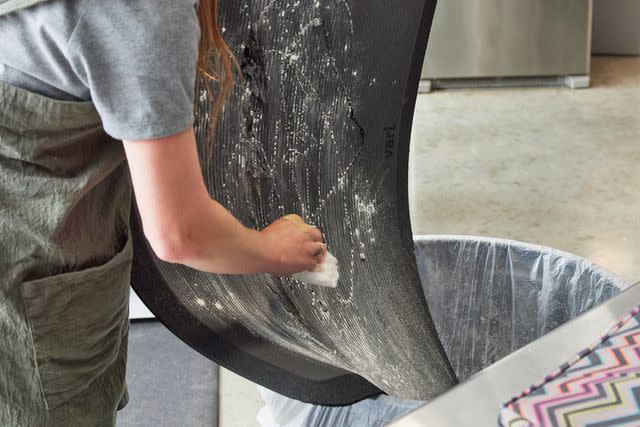
Food & Wine / Fred Hardy
What Didn't Make the List
Strong Contenders
Nama Standing Mat ($79 at House of Noa)
While this mat is very stylish and comfortable, it slid around a bit. Also, the current color options have light bases, which show dirt and spills easily and required frequent cleaning during our tests.
ComfiLife Anti-Fatigue Floor Mat ($42 at Amazon)
This mat was very comfortable, and comparable to the Kangaroo mat on this list (it, too, comes in several colors). Ultimately, we left it off due to the lack of sizes and colors.
Vari Standing Mat ($65 at Amazon)
This mat is available in two sizes and provides a decent amount of support. But, it's expensive, moves around on the floor, and its ridged surface (while great for providing grip) is difficult to clean. It would likely fare better in an office.
Ninja Premium Anti-Fatigue Comfort Mat ($20 at Amazon)
This mat didn't provide much support and seemed to "bottom out," as one tester said, as her heels could feel the bare floor beneath the mat. It also had a textured surface that made it somewhat difficult to clean.
Other Anti-Fatigue Mats We Tested
Testing 16 anti-fatigue mats, we found that some were noticeably less comfortable than others. Among them was the KMAT Kitchen Mat Cushioned Anti-Fatigue Floor Mat ($24 at Amazon). We wish were thicker to offer more support, and we found its textured design hard to clean. We were also a bit disappointed with the Sky Solutions Oasis Anti-Fatigue Mat ($43 at Amazon), as it felt hard and could have used more traction on the underside.
Frequently Asked Questions
How do anti-fatigue mats work?
Anti-fatigue mats are designed to reduce fatigue by tricking your body into making small movements with your legs and feet as you adjust to stabilize yourself on the cushioned surface. That in turn improves blood circulation and keeps your legs from feeling stagnant. Also, research suggests that using anti-fatigue mats decreases the lower back pain that people feel standing on a bare floor.
How do you clean anti-fatigue mats?
As a rule, you should always reference the manufacturer's instructions to get specific details on how to clean your anti-fatigue mat. Yet, most mats with water-resistant surfaces can be wiped down with a wet towel or rinsed in the sink.
How long do anti-fatigue mats last?
It depends on the quality of the mat and how much daily use it endures. Ideally, your mat should last between one to three years, but commercial-grade mats may last even longer.
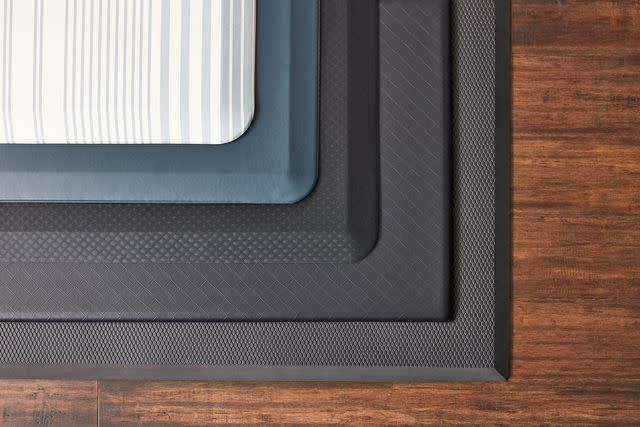
Our Expertise
Bernadette Machard de Gramont is an LA-based freelance writer specializing in food, wine, and kitchen products. After a two-year stint at Williams Sonoma headquarters in San Francisco, she now researches and tests a variety of cookware, bakeware, and wine tools, and interviews field experts for their insight.
For more Food & Wine news, make sure to sign up for our newsletter!
Read the original article on Food & Wine.

